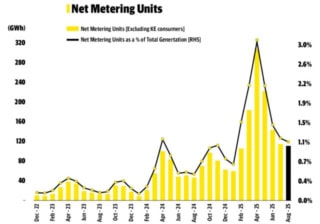Many Karachi residents were left puzzled when their solar-powered homes still received high K-Electric[1] bills in August. Despite investing in rooftop solar to cut costs, households saw little relief. So, what went wrong?
Solar Generation Dipped Sharply in August
According to reports, even homes equipped with rooftop solar systems ended up paying more in August due to poor generation output. For instance, one household with a 1,100-square-yard roof, half covered in panels, produced 1,304 kWh in August. In September, however, the same system generated 1,503 kWh, showing a clear recovery as weather conditions improved.
At the national level, solar power contributed only 0.7% of Pakistan’s total electricity generation of 14,218 GWh in August. This figure highlights how weather and technical limitations can impact the country’s clean energy progress.
Here’s a graph depicting net metering share in total generation, reflecting increased solar adoption and decreased grid dependence:


Heavy Clouds and Monsoon Rains to Blame
Experts say the main culprit was the monsoon. Dr. Javed Iqbal, Director at the Institute of Space and Planetary Astrophysics, University of Karachi, said:
“Cloud cover was the major reason for poor solar generation.”
Karachi experienced record rainfall on August 20–21, with 163.5 mm recorded at the old airport terminal, one of the heaviest downpours in decades.
Dense clouds during this period drastically reduced sunlight reaching the panels, cutting power output across the city.
Outages and System Shutdowns Made It Worse
Another major factor was power outages. Many areas faced prolonged blackouts during heavy rain. Due to anti-islanding protection, solar inverters automatically shut off when the grid goes down. This safety feature prevents power from flowing back into the grid, but it also stops homes from using their solar energy during outages.
Heat, Dust, and Pollution Also Hurt Efficiency
High temperatures further reduced efficiency; panels lose about 0.5% output per °C increase over 25 °C. Moreover, Karachi’s dusty air and pollution can block sunlight, reducing energy production by up to 60% if panels are not regularly cleaned.
The Takeaway
August’s case proves that even solar-powered homes remain vulnerable to environmental and grid challenges. For consistent savings, homeowners must maintain panels, monitor production, and prepare for weather-driven dips. As Pakistan expands its solar footprint, addressing these real-world challenges will be crucial to ensure reliable and clean energy for all.
References
- ^ K-Electric (ke.com.pk)
